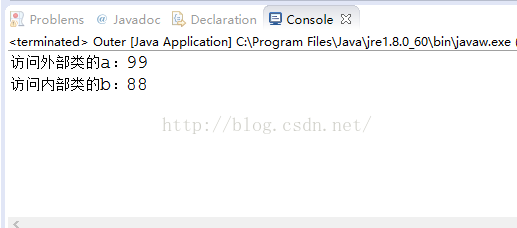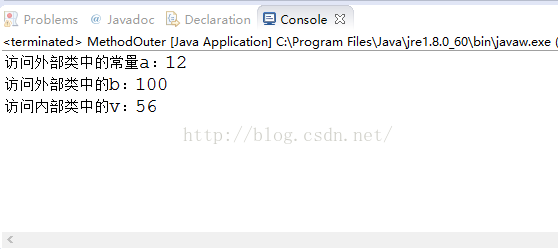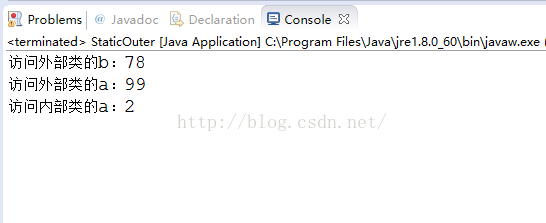Use of inner classes in Java
1. The role of inner classes
1. Inner classes provide better encapsulation. They can hide inner classes in outer classes and do not allow other classes in the same package to access them.
2. The methods of the inner class can directly access all data of the outer class.
3. More convenient to use.
2. Classification of inner classes:
1. Member inner class (as a member of the outer class)
2. Static inner class
3 .Method inner class (the inner class is inside a method of the outer class)
4.Anonymous inner class
3. The use of inner classes
1.Member inner class Usage:
<span style="font-family:Microsoft YaHei;font-size:18px;">package com.bluesky;
public class Outer {
private int a =99; //定义外部类的数据成员
public class Inner{ //该内部类作为外部类的一个成员
int b =88; //内部类的数据成员
public void test(){
System.out.println("访问外部类的a:"+a); //访问外部类的数据成员
System.out.println("访问内部类的b:"+b); //访问内部列的数据成员
}
}
public static void main(String[] args) {
Outer o = new Outer(); //先生成一个外部类的对象实例
Inner in = o.new Inner(); //产生一个内部类的对象实例
in.test(); //调用内部类的方法
}
}</span>Running results:

2. Use of static inner classes
package com.bluesky;
public class MethodOuter {
public void test(){
final int a=12;
int b=100;
class Inner{ //该内部类定义在外部类的方法的内部
public void print(){
int v=56;
System.out.println("访问外部类中的常量a:"+a);
System.out.println("访问外部类中的b:"+b);
System.out.println("访问内部类中的c:"+v);
}
}
Inner in = new Inner(); //在方法体里面先产生内部类的对象实例
in.print(); //在外部类的方法里面调用内部类的方法
}
public static void main(String[] args) {
MethodOuter mo = new MethodOuter(); //产生外部类的对象实例
mo.test(); //调用外部类的方法
}
}Running results:

3. Use of static inner classes:
package com.bluesky;
public class StaticOuter {
private static int a=99;
static int b =78;
public static class Inner{ //定义静态内部类
static int a=2;
public void test(){
System.out.println("访问外部类的b:"+b);
System.out.println("访问外部类的a:"+StaticOuter.a);
System.out.println("访问内部类的a:"+a);
}
}
public static void main(String[] args) {
Inner in = new Inner(); //因为是静态的,所有可以直接产生对象实例
in.test(); //调用静态内部类的方法
}
}Running results:

Put anonymous inner classes at the back. Stay tuned!
The above is the content of the use of internal classes in Java. For more related content, please pay attention to the PHP Chinese website (www.php.cn)!

Hot AI Tools

Undresser.AI Undress
AI-powered app for creating realistic nude photos

AI Clothes Remover
Online AI tool for removing clothes from photos.

Undress AI Tool
Undress images for free

Clothoff.io
AI clothes remover

AI Hentai Generator
Generate AI Hentai for free.

Hot Article

Hot Tools

Notepad++7.3.1
Easy-to-use and free code editor

SublimeText3 Chinese version
Chinese version, very easy to use

Zend Studio 13.0.1
Powerful PHP integrated development environment

Dreamweaver CS6
Visual web development tools

SublimeText3 Mac version
God-level code editing software (SublimeText3)

Hot Topics
 1385
1385
 52
52
 Perfect Number in Java
Aug 30, 2024 pm 04:28 PM
Perfect Number in Java
Aug 30, 2024 pm 04:28 PM
Guide to Perfect Number in Java. Here we discuss the Definition, How to check Perfect number in Java?, examples with code implementation.
 Weka in Java
Aug 30, 2024 pm 04:28 PM
Weka in Java
Aug 30, 2024 pm 04:28 PM
Guide to Weka in Java. Here we discuss the Introduction, how to use weka java, the type of platform, and advantages with examples.
 Smith Number in Java
Aug 30, 2024 pm 04:28 PM
Smith Number in Java
Aug 30, 2024 pm 04:28 PM
Guide to Smith Number in Java. Here we discuss the Definition, How to check smith number in Java? example with code implementation.
 Java Spring Interview Questions
Aug 30, 2024 pm 04:29 PM
Java Spring Interview Questions
Aug 30, 2024 pm 04:29 PM
In this article, we have kept the most asked Java Spring Interview Questions with their detailed answers. So that you can crack the interview.
 Break or return from Java 8 stream forEach?
Feb 07, 2025 pm 12:09 PM
Break or return from Java 8 stream forEach?
Feb 07, 2025 pm 12:09 PM
Java 8 introduces the Stream API, providing a powerful and expressive way to process data collections. However, a common question when using Stream is: How to break or return from a forEach operation? Traditional loops allow for early interruption or return, but Stream's forEach method does not directly support this method. This article will explain the reasons and explore alternative methods for implementing premature termination in Stream processing systems. Further reading: Java Stream API improvements Understand Stream forEach The forEach method is a terminal operation that performs one operation on each element in the Stream. Its design intention is
 TimeStamp to Date in Java
Aug 30, 2024 pm 04:28 PM
TimeStamp to Date in Java
Aug 30, 2024 pm 04:28 PM
Guide to TimeStamp to Date in Java. Here we also discuss the introduction and how to convert timestamp to date in java along with examples.
 Java Program to Find the Volume of Capsule
Feb 07, 2025 am 11:37 AM
Java Program to Find the Volume of Capsule
Feb 07, 2025 am 11:37 AM
Capsules are three-dimensional geometric figures, composed of a cylinder and a hemisphere at both ends. The volume of the capsule can be calculated by adding the volume of the cylinder and the volume of the hemisphere at both ends. This tutorial will discuss how to calculate the volume of a given capsule in Java using different methods. Capsule volume formula The formula for capsule volume is as follows: Capsule volume = Cylindrical volume Volume Two hemisphere volume in, r: The radius of the hemisphere. h: The height of the cylinder (excluding the hemisphere). Example 1 enter Radius = 5 units Height = 10 units Output Volume = 1570.8 cubic units explain Calculate volume using formula: Volume = π × r2 × h (4
 How to Run Your First Spring Boot Application in Spring Tool Suite?
Feb 07, 2025 pm 12:11 PM
How to Run Your First Spring Boot Application in Spring Tool Suite?
Feb 07, 2025 pm 12:11 PM
Spring Boot simplifies the creation of robust, scalable, and production-ready Java applications, revolutionizing Java development. Its "convention over configuration" approach, inherent to the Spring ecosystem, minimizes manual setup, allo




